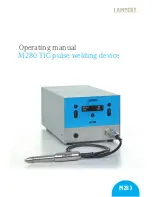
8785115
200A Multi-Process Welder with LCD Display
V4.0
28
For technical questions call 1-800-665-8685
WIRE FEED ROLLER SELECTION
The importance of smooth, consistent wire feeding during MIG welding cannot
be emphasized enough. The smoother the wire feed, the better the weld.
Feed rollers, also called drive rollers, feed the wire mechanically along the
length of the welding torch.
Feed rollers are designed for certain types of welding wire and they have different
types of grooves machined in them to accommodate the different types of wire. The
wire is held in the groove by the top roller of the wire drive unit and is referred to as
the pressure roller. Pressure is applied by a tension arm, which can be adjusted to
increase or decrease the pressure as required. The type of wire will determine how
much pressure may be applied and what type of drive roller is best suited to obtain
optimum wire feed.
V-Shaped Groove -
Solid hard wire, like steel or stainless steel, require a drive roller
with a V-shape groove for optimum grip and drive capability. Solid wires can have
more tension applied to the wire from the top pressure roller that holds the wire in
the groove and the V shape groove is more suited for this. Solid wires are more
forgiving to feed due to their higher cross sectional column strength. They are
stiffer and do not easily bend.
U Shaped Groove -
Soft wire, like Aluminum, requires a U-shape groove.
Aluminum wire has less column strength, can bend easily and is therefore more
difficult to feed. Soft wires can easily buckle at the wire feeder where the wire
enters the torch’s inlet guide tube. The U-shaped roller offers more surface area
grip and traction to help feed the softer wire. Softer wire also requires less
tension from the top pressure roller to avoid deforming the wire’s shape. Too
much tension will push the wire out of shape and cause it to catch in the
contact tip.
Knurled Drive Roller
- Flux core/gasless wire is made of a thin metal sheath
that has fluxing and metal compounds layered onto it, which is then rolled
into a cylinder to form the finished wire. The wire cannot take too much
pressure from the top roller, as it can be crushed and deformed. A knurled
drive roller was developed with small serrations in the groove. The serrations
grip the wire and assist to drive it without too much pressure from the top
roller. The down side of using a knurled wire feed roller with flux cored wire is
it will slowly eat away at the surface of the welding wire over time. These
















































